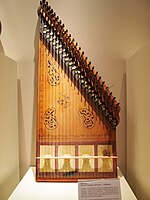Qanun (instrument)
This article has multiple issues. Please help improve it or discuss these issues on the talk page. (Learn how and when to remove these template messages)
|
 Armenian Qanun, 19th century | |
| String instrument | |
|---|---|
| Classification |
|
| Developed | Antiquity |
| Playing range | |
| (F2)A2-E6(G6) | |
| Related instruments | |
The qanun, kanun, ganoun or kanoon (
Regional variants and technical specifications
Arabic qanuns are usually constructed with five skin insets that support a single long bridge resting on five arching pillars, whereas the somewhat smaller Turkish qanuns are based on just four. This allows Arabic variants of the instrument to have more room for the installation of extreme bass and treble strings. Kanuns manufactured in Turkey generally feature 26
Ornamental sound holes called kafes are a critical component of what constitutes the accustomed timbre of qanun. However, they normally occupy different locations on the soundboard of Turkish kanuns compared to Arabic qanuns, and may also vary in shape, size and number depending on geography or personal taste.
The dimensions of a Turkish kanun are typically 95 to 100 cm (37–39") in length, 38 to 40 cm (15–16") in width, and 4 to 6 cm (1.5–2.3") in height.[2] In contrast, an Arabic qanun measures a bit larger as mentioned.[3]
Qanun is played on the lap while sitting or squatting, or sometimes on trestle support, by plucking the strings with two tortoise-shell picks (one for each hand) or with fingernails, and has a standard range of three and a half octaves from A2 to E6 that can be extended down to F2 and up to G6 in the case of Arabic designs.
The instrument also features special metallic levers or latches under each course called mandals. These small levers, which can be raised or lowered quickly by the performer while the instrument is being played, serve to slightly change the pitch of a particular course by altering effective string lengths.[4]


Tuning and temperament
On the regular
With the advent of
On the other hand, the nowadays widespread application of equidistant 24-tones on Arabic and 72-tones on Turkish qanun models presents an ongoing source of controversy.
Alternate tuning approaches for the qanun thus also exist. Turkish music theorist Ozan Yarman has proposed, for example, an academical 79-tone temperament for the expression within tolerable error-margins of
Notable players

See also
References
- ^ a b "Qanoon". furatmusic.com.
- ^ Aydoğdu, Gültekin; Aydoğdu, Tahir (2018-02-11). "'Kanun' hakkında". turksanatmuzigi.org: Salih Bora.
- ^ "About The Qanun". www.middleeasterndance.net. Retrieved 2016-06-26.
- ISBN 978-0-520-27515-7.
- ^ Nasuhioğlu, Orhan (December 1986). Türk Musikisi – Rauf Yekta Bey. Pan Yayıncılık. pp. 92–93.
- ISBN 978-1-56159-263-0– via Oxford Music Online.
- ^ Yarman, Ozan (2008). 79-tone Tuning & Theory For Turkish Maqam Music As A Solution To The Non-Conformance Between Current Model And Practice (PDF). Istanbul Technical University: Institute of Social Sciences: unpublished Doctoral Dissertation. pp. 2–3, 92, 126.
- ^ Aydoğdu, Tahir; et al. (2012). "1. ULUSLARARASI KANUN SEMPOZYUMU VE FESTİVALİ Program ve Özetler" (PDF). (I. International Qanun Symposium & Festival). Archived from the original (PDF) on 2016-10-23. Retrieved 2016-06-27.
- ^ Aydoğdu, Tahir; et al. (2015). "2. ULUSLARARASI KANUN SEMPOZYUMU VE FESTİVALİ synopsis". (II. International Qanun Symposium & Festival).
- S2CID 57766225.
- ^ Signell, Karl (1977). Makam – Modal Practice in Turkish Art Music. Washington: Asian Music Publications. pp. 37–47, 151–61.
- ^ Güleç, Levent & Bülent. "Ejder Müzik Aletleri". www.ejdermuzik.com. Retrieved 2016-06-27.
- ^ "79-tone qanun recipe". www.ozanyarman.com. Retrieved 2016-06-26.
- ^ Pohlit, Stefan (2011). Julien Jalâl Ed-Dine Weiss: A Novel Tuning System for the Middle-Eastern Qānūn. Istanbul Technical University: Institute of Social Sciences: unpublished Doctorate Dissertation.
Further reading
- Farraj, Johnny; Shumays, Sami Abu (2019). Inside Arabic Music: Arabic Maqam Performance and Theory in the 20th Century. Oxford: Oxford University Press. ISBN 978-01906-5-835-9.
External links
- William McClure Thomson, (1860): The Land and the Book: Or, Biblical Illustrations Drawn from the Manners and Customs, the Scenes and Scenery, of the Holy Land Vol II, p. 577.
